MARIANI’S
Virtual
Gourmet
July 12 ,
2020
NEWSLETTER
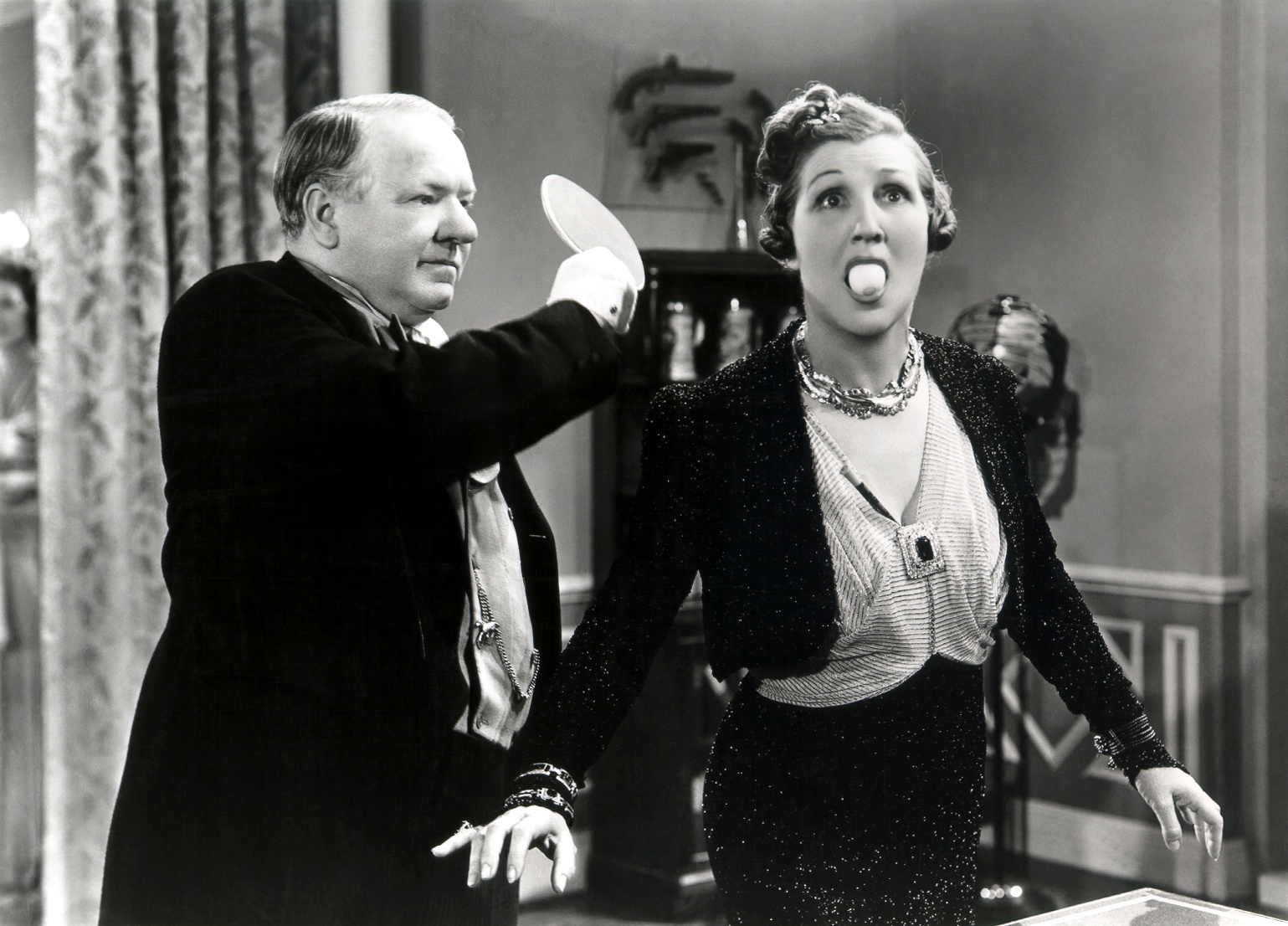
W.C.
Fields and Jan Duggan in You Can't Cheat an Honest
Man (1939)
❖❖❖
IN THIS ISSUE
WHAT'S NEXT FOR VEGAS?
By John A.
Curtas
NEW YORK CORNER
LOVE AND PIZZA
Chapter Sixteen
By John Mariani
NOTES FROM THE WINE CELLAR
THE WINES OF ROCHIOLI
By John Mariani
❖❖❖
WHAT’S NEXT FOR LAS
VEGAS?
By John A. Curtas

Assuming
they’re
still around a month from now, restaurants
surviving this
coronapocalypse will face a strange new world of
fewer customers, freaked out
diners, intense public health scrutiny, and a
depleted workforce—all while
trying to resurrect their economic lifelines and
deal with supply chains in
ruins. When
it comes to Las Vegas, the effects of the pandemic
have affected tow main sectors: the
off-Strip dining scene,
which was starting to boom over the past three
years; and the Strip, with its
hundreds of food outlets serving
(primarily) our tourist economy. There are no
crystal balls at work here, and
some of my predictions are beyond obvious, but
they bear reminding to brace
yourself for the brave new world in eating out
that's right around the
corner.And for the record, it would please us no
end if we are proved totally
wrong on all of them. Well, almost all of them.
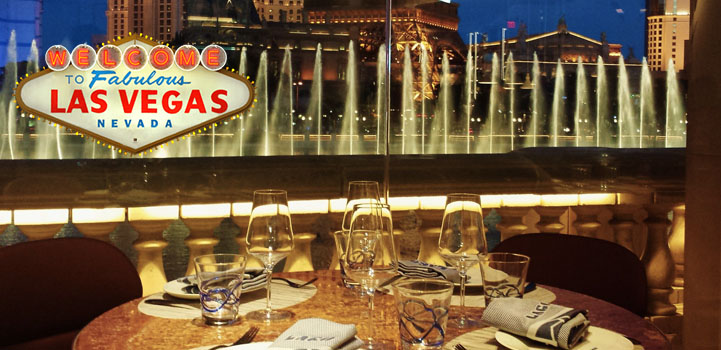 Fewer Diners
Fewer Diners
Everything's
about to shrink: customer base, restaurant seating,
booze consumption, and
profits. Those people you see dancing in the
streets? Bankruptcy lawyers.
Shorter menus
Every menu
in America that isn't a Chick-Fil-A’s has just been
cut in half. Many will stay
that way. Shorter menus are great for many reasons,
but mainly because you can
spend less time ordering and more time worrying
about that cough from four
tables away.
Close tables
Cheek-by-jowl
jostling
with strangers over a plate of steak frites has gone
from good to
gauche. Huge Strip restaurants (e.g.
300-seat places, 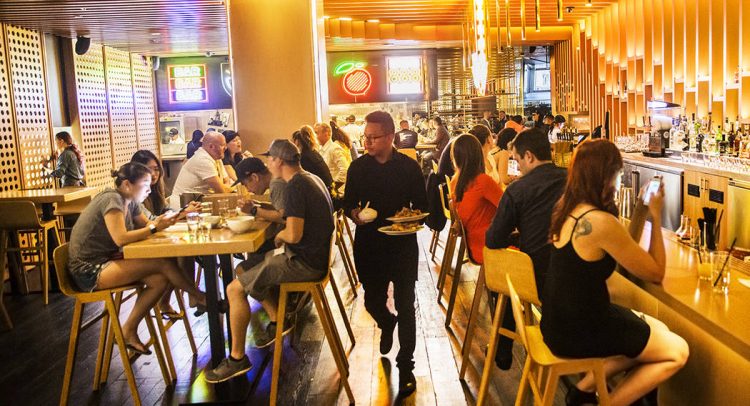 like Mon Ami Gabi)
will reduce capacity and suddenly find themselves
with a third fewer tables.
Tiny neighborhood joints will feel the pressure too.
Guess which ones will be
hurt the most? A fifty-seat mom-and-pop
cracker box probably can't
survive if its profit is cut in half. No word yet
from epidemiologists on the
disease-catching horrors lurking in back-to-back
booths.
like Mon Ami Gabi)
will reduce capacity and suddenly find themselves
with a third fewer tables.
Tiny neighborhood joints will feel the pressure too.
Guess which ones will be
hurt the most? A fifty-seat mom-and-pop
cracker box probably can't
survive if its profit is cut in half. No word yet
from epidemiologists on the
disease-catching horrors lurking in back-to-back
booths.
Loud and Crowded
Goes Kaput
A corollary
to "close tables" above. Three-deep bars and people
screaming to be
heard will be seen as toxic. In well-spaced,
too-quiet places, expect people to
start yelling across tables just for old time's
sake. Baby Boomers, mostly.
Communal Tables
No one will
want to dine next to strangers anymore. From now on,
people will let public
health doctors tell them how they should sit and
socialize —in the same way we
let dentists tell us what food to chew.

Buffets
Put a fork
in them, they're done. Forget about sanitary masks
and table-spacing— after
this world-wide meltdown, no one's going to want to
stand in line with hundreds
of strangers while waiting to eat, much less handle
a serving spoon that's been
touched by fifty messy kids.
Opposing
view: Death by calories does not dissuade these
eager over-eaters from their
orgies of excess. The same people will be only too
eager to resume shoveling
All-You-Can-Eat into their pie holes, as soon as
some authority figure says it's
"okay." Catching a virus may have terrified them in
the short-term,
but government can stand only so long between a man
and his third dessert.
Smaller Plates
Here's one
we're on the fence about. Will portions shrink
to reflect tougher times?
Or will the good old "blue plate special/meat
and three" make a comeback? In other words,
will gutsy food replace
preciousness? One thing's for sure though, there
will no longer be restaurants
centered around . . .
Shared Plates
Shared
plates (and/or everyone picking off a central
platter) will NOT be a theme of
most menus anymore. You might as well say to your
friends, "Let's go
infect each other over dinner." You'll now get a lot
of "Ewwww"
at the very thought of sharing food. If you want to
eat communally, you'll have
to go the Chinese banquet route. Possibly in a
private room. Probably with a bureaucrat standing over
your shoulder.
Tweezer Food
Can't die a
moment too soon. As Julia Child once said (when
looking at a nouvelle cuisine
creation): "You can just tell someone's fingers have
been all over
it." The absurdity of molecular cuisine will perish
in a sea of silly
foam.
Long Tasting
Menus
Once the
dust settles, the one percent will start flocking
back to destination
restaurants. Or will they? Something tells us all
the "chef's vision"
malarkey— which has powered the World's 50 Best for
the past decade—will
henceforth be seen as decadent. Simple, local
cooking with good ingredients
will replace three-hour slogs through some overpraised,
hipster chef's fever dream.
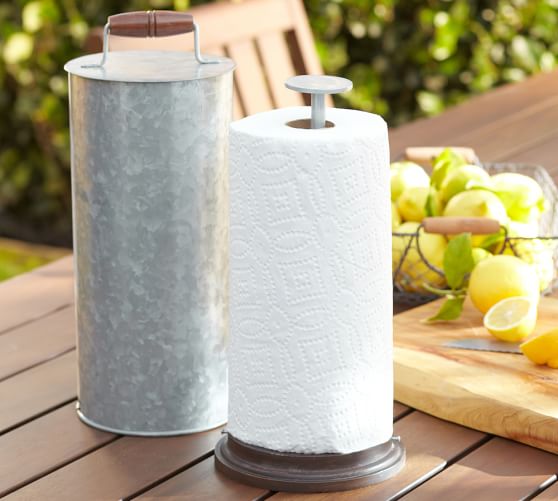 Linens?
Sanitary or Un-?
Linens?
Sanitary or Un-?
Personally,
many who dine out often long for the days of real
cotton napery and tablecloths. We
prefer them to wet, slimy, cold,
hard surfaces where who-knows-what has been smeared.
Unfortunately, it's a
cinch the health departments will mandate the
constant wiping down of tables,
and human comfort and civilized dining will be the
casualties, at least in
America. We can't imagine the old-school, haute
cuisine palaces of France
serving dinner on bare-bones tables, although some
already do. The smart set
will bring their own cleaning supplies— because
nothing says "night on the
town" like Handi-Wipes and a personalized spray
bottle.
More Plastic!
The world's
fear of viral infection will make clean freaks out
of everyone. And this means
more single-use plastic: gloves, Styrofoam
containers, take-home boxes,
utensils, etc. Germaphobes will have a field day
"protecting" us from
cooties, even if it means ruining our long-term
health and the environment.
This is known in public health circles as saving
your life by killing
everything around you.
Sommeliers
Sad to say,
but somms will be an
endangered species
in this new economy. Wine lists will shrink; prices
will come down; and
choosing a bottle will
be between you and your
wine
app. This will save you money (on
tips, too) and gallons of
self-esteem by no longer being humiliated because
you don’t know the difference
between a Malagousia
and a Moscofilero.
bottle will
be between you and your
wine
app. This will save you money (on
tips, too) and gallons of
self-esteem by no longer being humiliated because
you don’t know the difference
between a Malagousia
and a Moscofilero.
Wine Bars
Expect wine
in general to take a hit, especially the expensive
stuff. Especially in
America. The health nuts will try (and fail) to turn
bars into fully automated
spaces with all the charm of a DMV waiting room.
Asian Food
Asian food,
specifically Chinese food, will suffer. Many blame
the Chinese government for
this current health debacle. While the blame may be
justified, this isn't fair
to Chinese-Americans or Chinese restaurants in
America. But fairness has no
place in post-Covid society. Once the tail starts
wagging the dog, don't expect
the bigoted bull to go easy on the China shop.
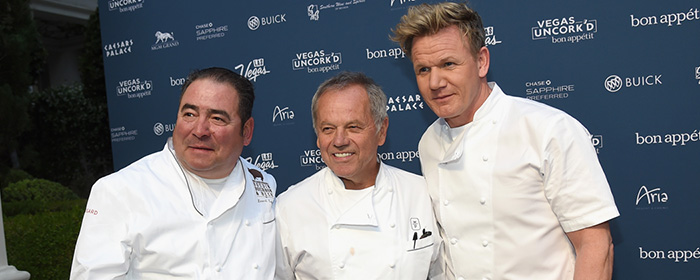 Celebrity Chefs
Celebrity Chefs
Their popularity has been shrinking for a while now. Is anyone dying to go to a Bobby Flay restaurant anymore? Even if Shark in The Palms is/was pretty good? Gordon Ramsay’s shtick will start looking even more stagey and superficial in the culture of asceticism to come. And because the cache of chefs has shrunk, Bad Boy Chefs are probably a thing of the past, too. Ditto their tattoos, and tatts on waitstaff and barkeeps as well. In this hyper-hygienic, monochromatic, new world order, anything that smacks of personal expression and pirate rituals will not be a good look when it comes to selling vittles. Imagine a world where everyone looks like super-sanitized clones, and you'll get the idea. Not sexy.
Take-out Food
Every
operator thinks this whole pick-up/delivery thing is
here to stay.
Doesn't matter that all food tastes better when
eaten right after it's
prepared. Good food doesn't travel well. Good food
needs to be eaten as soon as
it's done. Human beings have known this for
thousands of years. But, because of
this shutdown, restaurants will try in vain to prove
otherwise. Eating take-out
from a good restaurant is like watching a
blockbuster movie on an iPhone.
Less Luxury
Spending
Bottle
service: dead. Ginormous nightclubs: toast.
Dayclubs: history. Smaller lounge
acts, showrooms, and supper clubs will be replacing
them, sending Vegas
straight back to 1975.
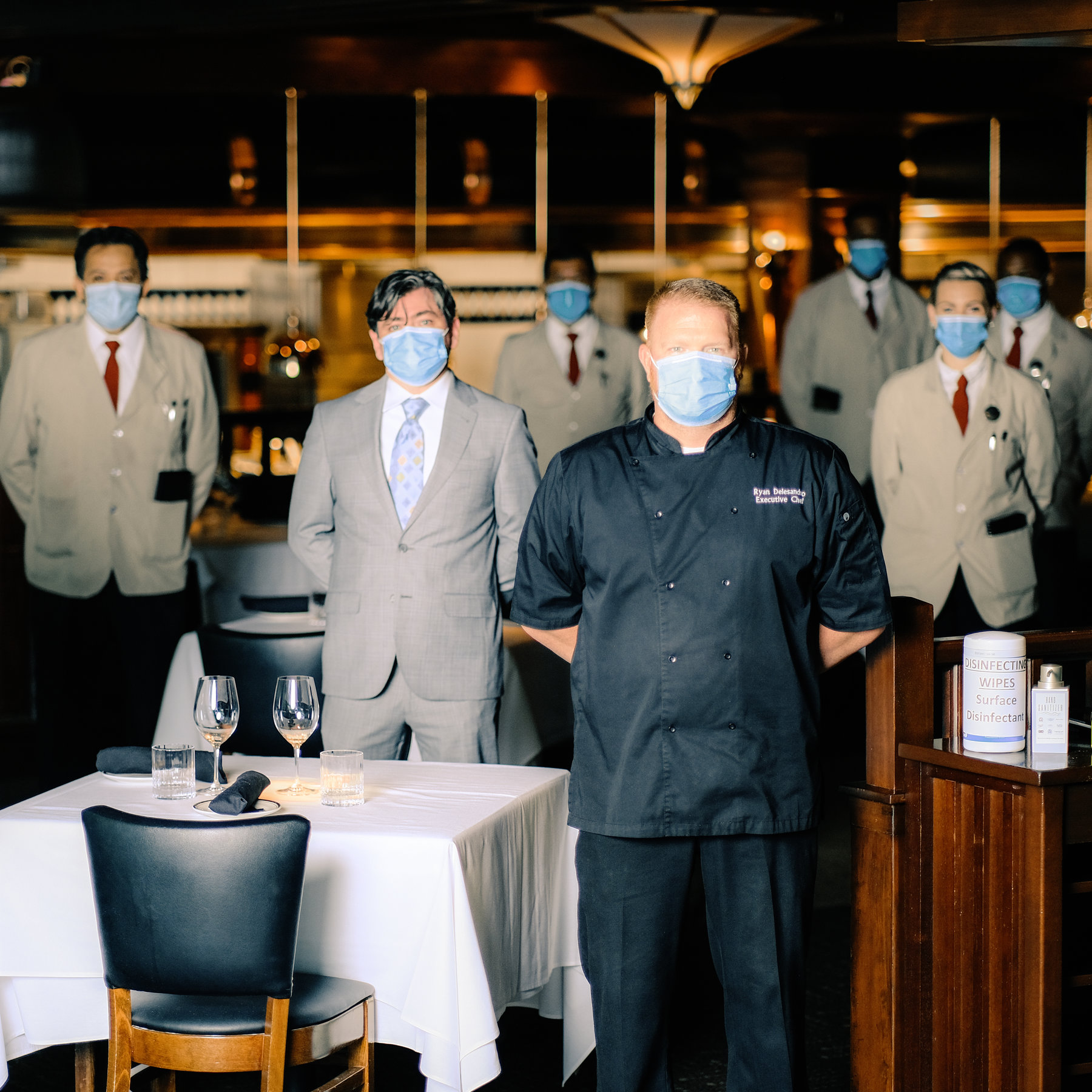 Hygiene Obsession
Hygiene Obsession
Will
everyone have to be tested before entering? Will
your waiter be wearing a mask?
Will all of these ruin your enjoyment of eating out
by turning restaurants into
the equivalent of hospital food being served by
prison guards in a boarding
school mess hall? Does the Pope wear a beanie?
❖❖❖
NEW YORK CORNER
By John Mariani
LOVE AND PIZZA
Since,
for the time being, I am unable to write about
or review New York City
restaurants, I have decided instead to print a
serialized version of my (unpublished) novel Love
and Pizza,
which takes place in New York and Italy
and involves a young, beautiful Bronx
woman named Nicola Santini from an Italian
family impassioned about food. As the
story goes on, Nicola, who is a student at
Columbia University, struggles to maintain her
roots while seeing a future that could lead
her far from them—a future that involves a
career and a love affair
that would change her life forever. So, while
New York’s restaurants remain closed, I will
run a chapter of the Love
and Pizza
each week until the crisis is over. Afterwards
I shall be offering the entire book
digitally. I hope you like
the idea and even more that you will love
Nicola, her family and her friends. I’d love
to know what you think. Contact me at loveandpizza123@gmail.com
—John Mariani
To read
previous chapters go to archive
(beginning with March 29, 2020, issue.
LOVE
AND PIZZA
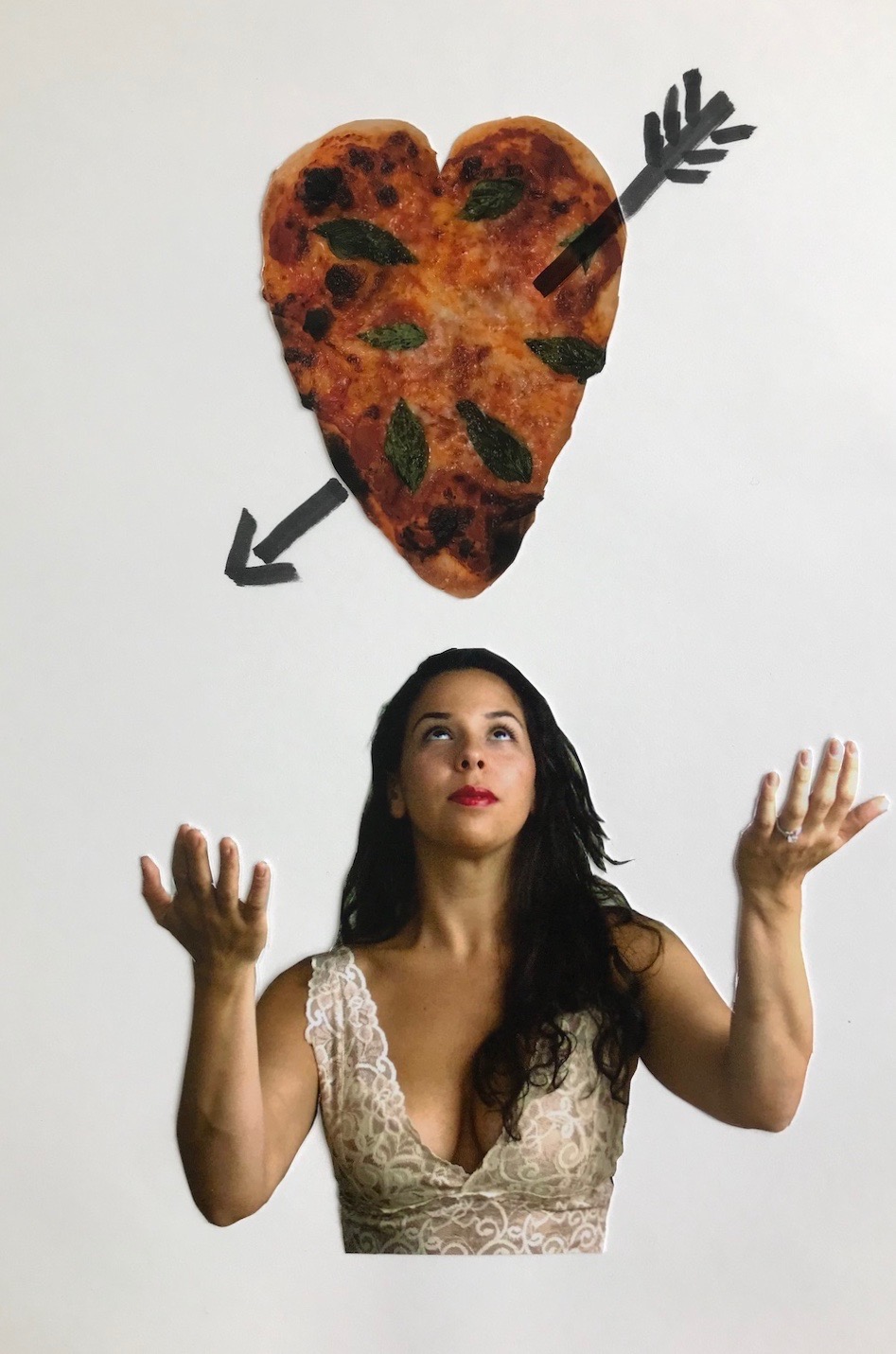
By
John Mariani
Cover Art By
Galina Dargery
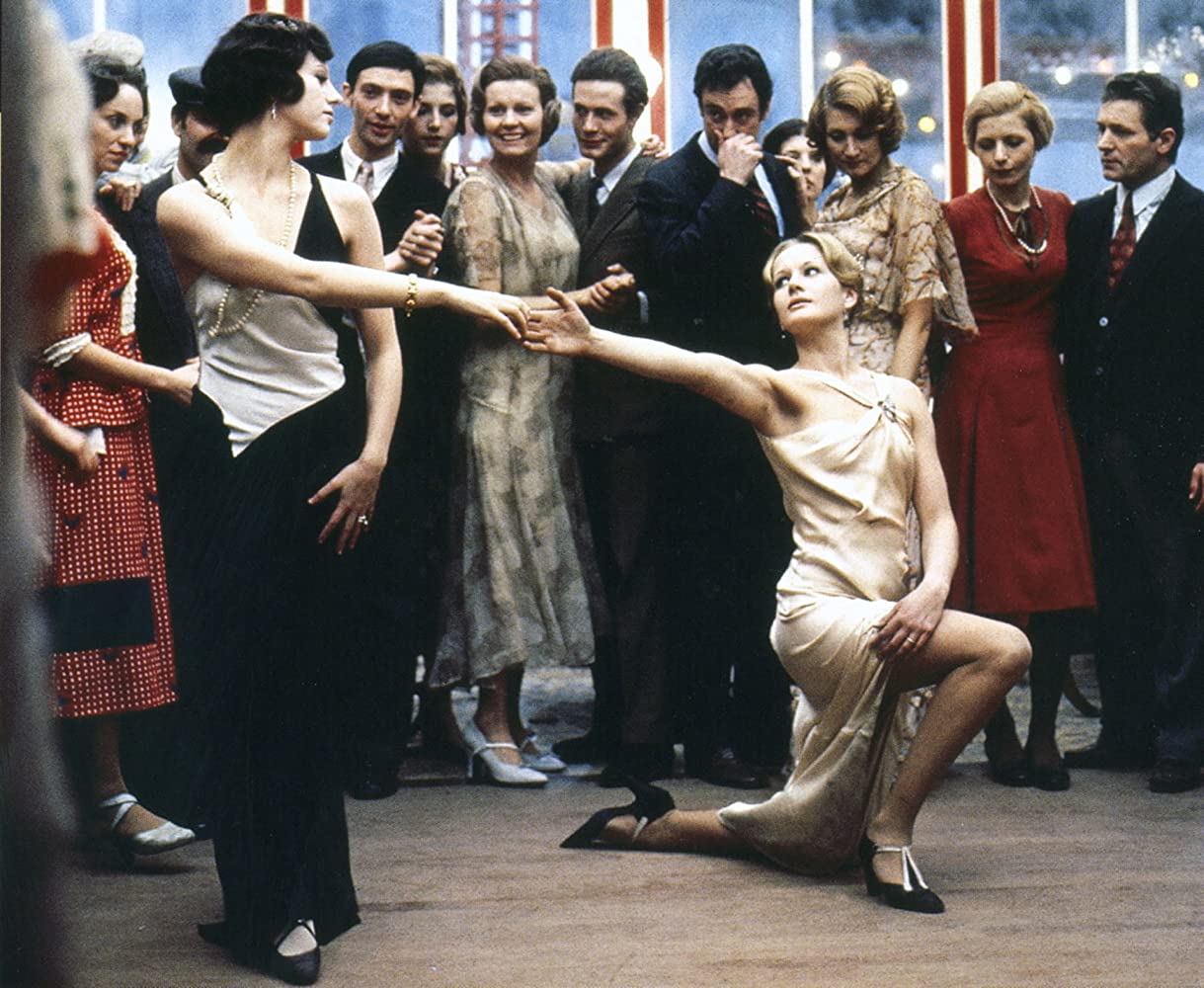
Stefania
Sandrelli and Dominique Sanda in The
Conformist (1970)
CHAPTER
SIXTEEN
Downstairs in the
spacious courtyard the show
was set inside a white canvas tent.
Positioned around the interior were movie
lights and the kind of props and technical
equipment found on a movie set,
including a boom microphone suspended above
the runway.
Attendees were seated in folding
canvas-backed chairs of the kind directors
used, instead of the ubiquitous
stiff gold chairs of the other shows.
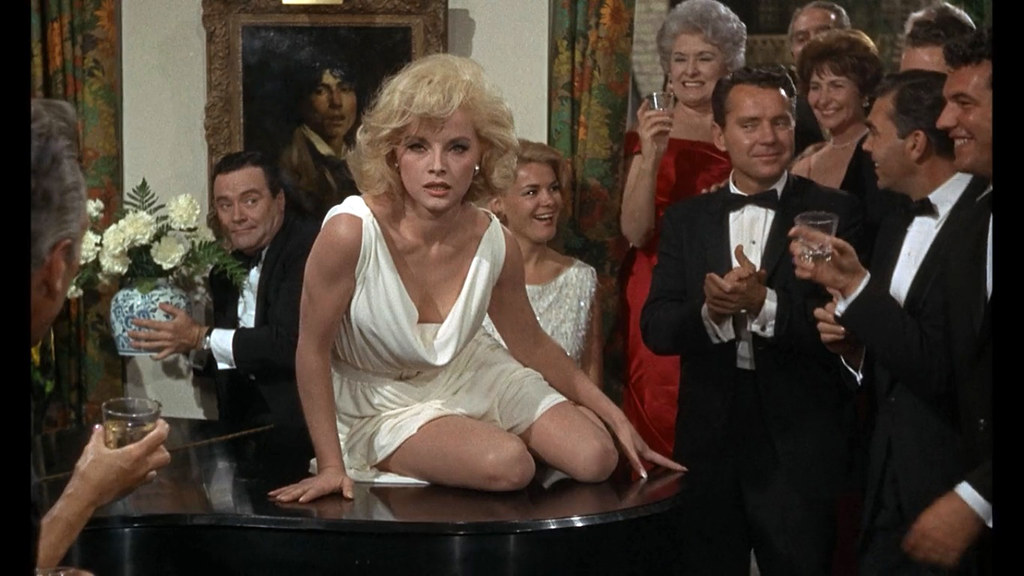 On the
walls were posters of movies that featured
Signora
Palma’s stars—Sophia Loren in
“Two Women” and “Yesterday, Today and
Tomorrow”; Gina Lollobrigida in
“Flesh and the Woman” and “Come
September”; Stefania Sandrelli in “Divorce
Italian Style” and “The Conformist”; Virna
Lisi in “How to Murder Your Wife”
(left)
and “The Secret of Santa Vittoria”; and
Claudia Cardinale in “8 ½” and “The
Pink Panther.”
On the
walls were posters of movies that featured
Signora
Palma’s stars—Sophia Loren in
“Two Women” and “Yesterday, Today and
Tomorrow”; Gina Lollobrigida in
“Flesh and the Woman” and “Come
September”; Stefania Sandrelli in “Divorce
Italian Style” and “The Conformist”; Virna
Lisi in “How to Murder Your Wife”
(left)
and “The Secret of Santa Vittoria”; and
Claudia Cardinale in “8 ½” and “The
Pink Panther.”
Signora
Palma had counted on it being a gray morning
in Milan, so bringing down the
lights inside the tent plunged the audience
into brief darkness. The designer was also
counting on her
belief that the audience—at least the
Italians, who were all cinema buffs—could
easily make the connection between the
actresses and the outfits from specific
movies, and those who could not could simply
enjoy the show with a little less
familiarity.
Then, to the sound of the soaring
violin strains of the theme from
Federico Fellini’s “Amarcord,” the spotlights
began scanning the tent’s ceiling
as in a movie premier, then focused on the
runway. After a moment of quiet,
with nerves running high backstage
and the audience in a reserved state of
amusement, the music from the
movie “Trapeze” began to play over
the speakers and a girl appeared, with a pixie
haircut and
bountiful cleavage, dressed in a
shimmering gold 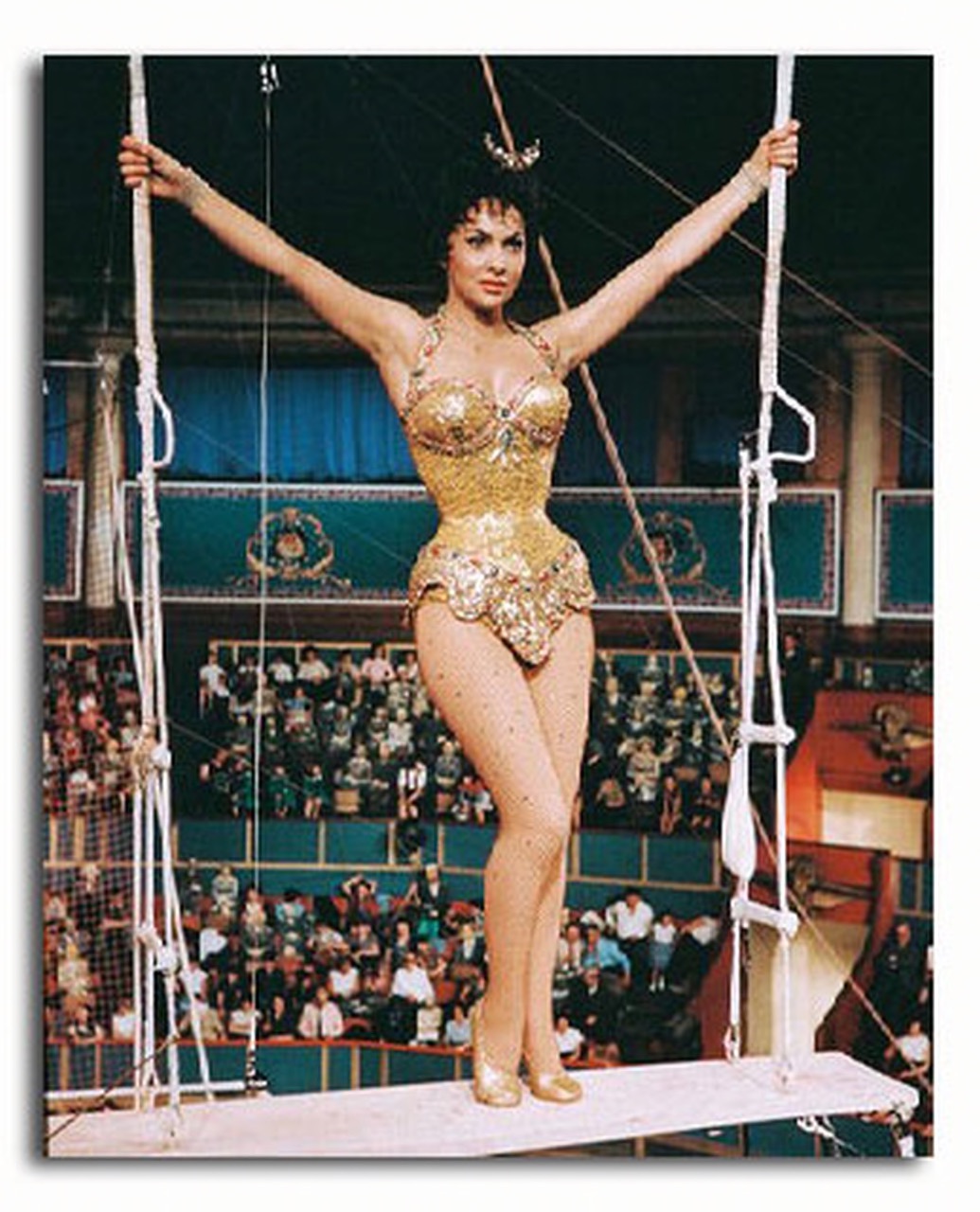 beaded
swimsuit that echoed the circus trapeze
performer’s
outfit in the movie. The model was smiling
radiantly and it had its effect: the
audience gasped or laughed or both, then
applauded, suddenly recognizing the
uncanny resemblance to Gina Lollobrigida—who
as long ago as 1954 had been on
the cover of Time magazine
as the
symbol of what it called “Hollywood on the
Tiber.”
beaded
swimsuit that echoed the circus trapeze
performer’s
outfit in the movie. The model was smiling
radiantly and it had its effect: the
audience gasped or laughed or both, then
applauded, suddenly recognizing the
uncanny resemblance to Gina Lollobrigida—who
as long ago as 1954 had been on
the cover of Time magazine
as the
symbol of what it called “Hollywood on the
Tiber.”
Next on the catwalk was the
German model,
impersonating Virna Lisi in the movie “The
Secret of Santa Vittoria,” wearing a
highly modified red checkered peasant blouse
and pleated brown wool skirt, with
a printed kerchief tied artfully on the model’s
blonde hair. The
dirge-like
coronet and mandolin music from “Divorce
Italian Style” (below) began and out walked
a
stunning facsimile of Stefania Sandrelli in
one of the most famous bathing
suits in cinema history, a tiny, strapless
bikini she wore lounging on the
yacht of her cuckolded new husband, 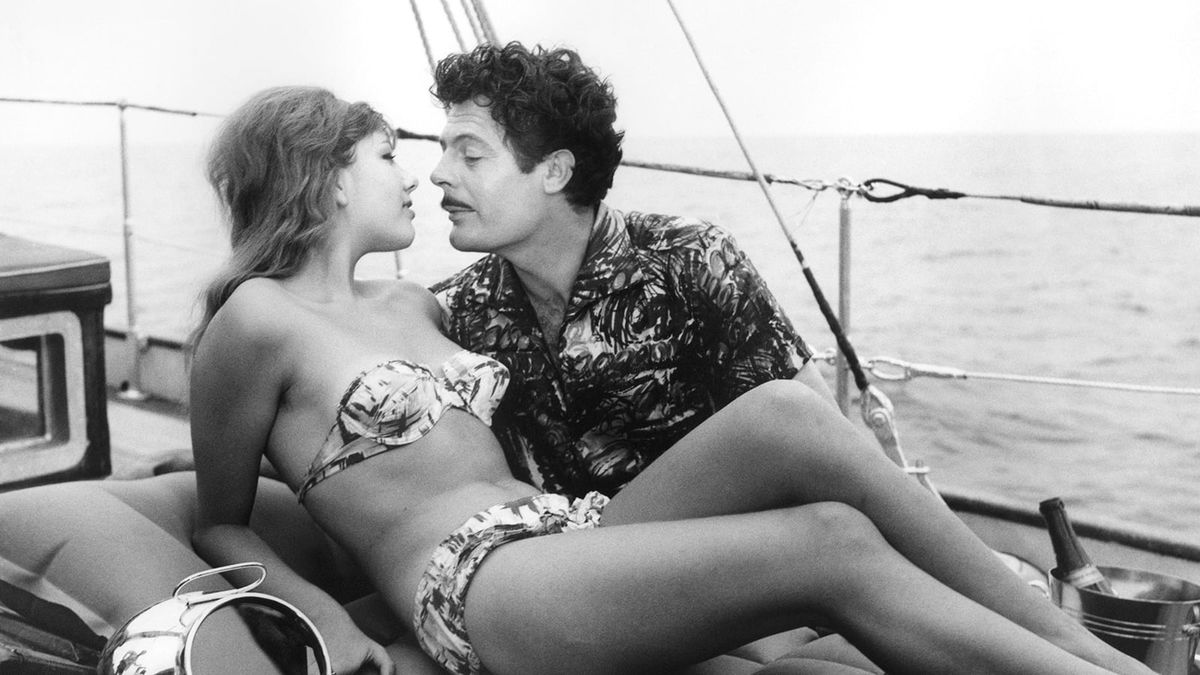 played
by Marcello Mastroianni.
played
by Marcello Mastroianni.
Signora
Palma was well aware this was supposed to be a
show exhibiting fall clothes,
but she wanted the eye-opening value of
showing swimsuits, too, which, if
things and sales went well, she could have in
the stores by June.
Next would come her homage
to Sophia Loren—who
often attended the big shows in Milan, but not
Patrizia Palma’s. When the audience heard
the music from “Yesterday,
Today and Tomorrow”—not quite familiar to
most—those who recognized it turned
to each other and said, “It’s going to be
Sophia Loren in that black bustier!”
referring to a hilariously sexy striptease
scene in one episode of the
movie.
But instead, since Signora
Palma didn’t have a lingerie
line, she sent out her model in a beautifully
tailored beige coat with a mink
collar, which Loren wore in the episode “Anna
of Milan,” as a wealthy
industrialist’s wife with a lover played by
Mastroianni.
The coat was an updated version of the
one Christian Dior had designed for that movie
segment, and the veteran fashion
watchers in the audience nodded to each other
knowingly that they saw the
connection.
Nicola
was next up. Her heart was pounding
wildly, her hands shaky, lips
slightly quivering. Signora
Palma was behind her, put her
hands on her shoulders, and said, “Buona
fortuna, cara,” and gave her a little
push. The first notes of Henry
Mancini’s comically suspenseful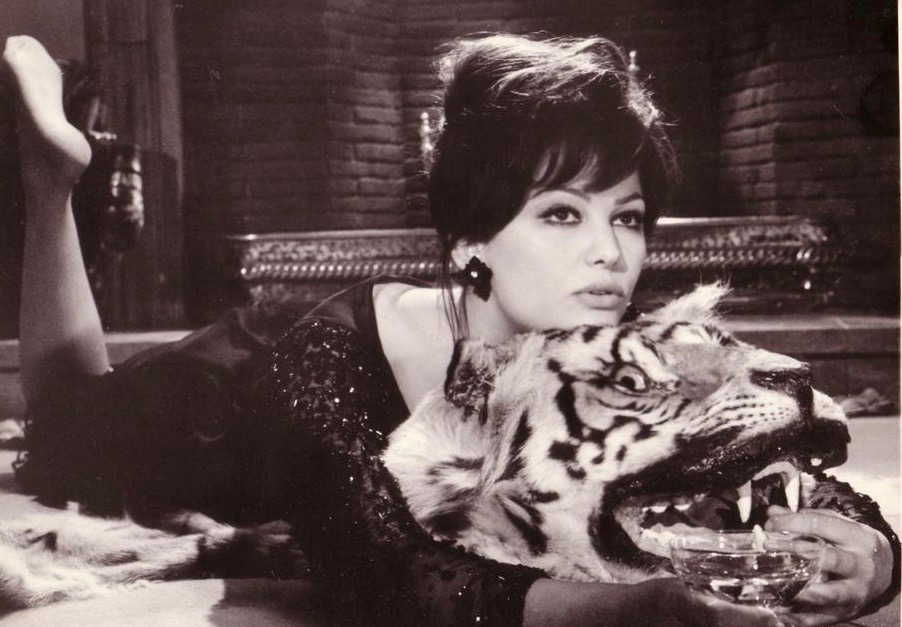 theme from “The Pink Panther” played, and
Nicola Santini, so very, very far
from the Bronx, walked onto the runway.
From the rear she heard Signora
Palma shout, “Smile, Nicola, big
smile!”
theme from “The Pink Panther” played, and
Nicola Santini, so very, very far
from the Bronx, walked onto the runway.
From the rear she heard Signora
Palma shout, “Smile, Nicola, big
smile!”
Nicola broke into a wide
grin then a big smile
and began walking girlishly on the runway, not
shifting her hips this way and
that as was then routine, but moving them
easily, as young women really do when
flirting.
But while the
music played, the audience seemed puzzlingly
quiet. Signora
Palma
looked at her staff, lifted her palms and
shrugged her shoulders, asking what
the hell had gone wrong?
Then, all of a sudden, the
audience broke into
wild applause, then shouts of “Claudia!” “La
Cardinale!” “Bellisima!” and it went on for
what seemed like hours to
Nicola.
She was dressed in an
interpretation of the actress’s stunning
sequined black lace dress (right)
worn in “The
Pink Panther” (right) when she visited cat
burglar David Niven’s hotel room, where she
proceeded to drink Champagne and lie atop a
tiger rug—a scene immediately
recognizable to everyone in the room.
The other models had gotten
wild applause, but
the acclimation for Nicola was well beyond
theirs, and something like a chant
of “Claudia” began as the audience clapped in
unison. Even in her terrified
state, Nicola was not oblivious to
what she heard, taking it more as a compliment
to the actress she was portraying
than to herself, as the waves of applause
continued. By the time she got to
the end of the runway—always smiling,
smiling—with the audience still roaring and
clapping, she didn’t know quite
what to do.
And then she remembered
Claudia Cardinale’s
famous pout, how her lower lip would emerge
from her perfect mouth, a signature
look as identified with the Italian actress as
a provocative wink was with
Marilyn Monroe.
So Nicola stopped
smiling—which actually caused a lessening of
the applause—and then . . . she pouted,
and the audience went crazy
again.
Signora Palma
was
ecstatic and told her staff, “I
knew
this girl would be perfect!”
then gestured for Nicola to come back.
At that moment Nicola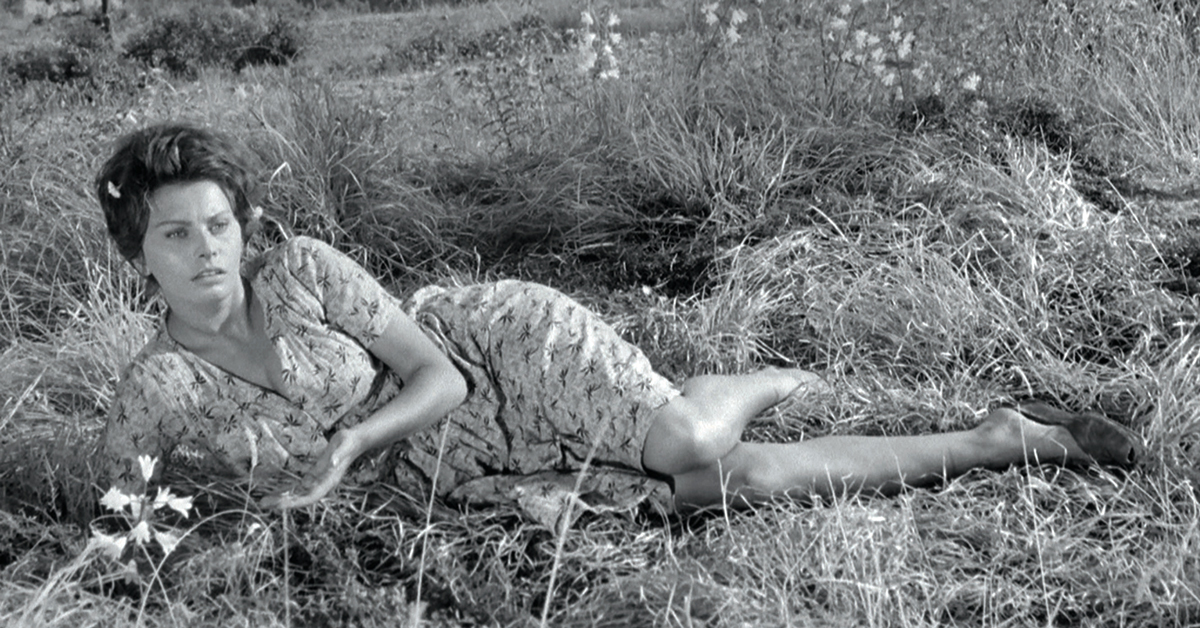 sensed the power of her own, or
Cardinale’s, very
Italian appeal, the luminous smile, the
darkness of the eyes, a dark
complexion, a natural bust line, shapely legs
and broad rounded shoulders—just
about everything that distinguished her from
the sallow, emaciated,
empty-headed look of a thousand other models
on Milan’s runways that week.
sensed the power of her own, or
Cardinale’s, very
Italian appeal, the luminous smile, the
darkness of the eyes, a dark
complexion, a natural bust line, shapely legs
and broad rounded shoulders—just
about everything that distinguished her from
the sallow, emaciated,
empty-headed look of a thousand other models
on Milan’s runways that week.
Was the audience’s reaction
for the dress or
for the model? By then it didn’t matter.
Signora
Palma pushed Nicola
out a few steps as many of the highly
sophisticated attendees actually rose to
their feet.
In the front row,
editors, writers and buyers sat frantically
scribbling notes in their notepads.
But the show had only just
begun: there were
twenty more outfits to go, which
would
include the elegant black and white silk gown
and pearls worn by
Sandrelli while dancing sensuously with
actress Dominique Sanda in “The
Conformist”; the slinky, low-cut tunic Lisi
wore in “How to Murder Your Wife”;
the loose print dress Loren (above)
wore throughout “Two Women,” for which she
received
an Academy Award; and much more—skirts,
blouses, coats, slacks, scarves and
belts.
Whenever
Nicola appeared the applause was still loud
and continuous,
though by the end of the show more out of
appreciation than astonishment. After
the “Pink Panther” dress, Nicola
wore a printed blouse with rounded collar and
a dark cardigan sweater as did
the very young Cardinale in “Rocco and His
Brothers”; a polka-dot shirtwaist
and scarf from “8 ½”; the extraordinary white
gown in the ballroom scene of “The
Leopard” (right)
where she danced with Alain Delon and Burt
Lancaster; and the white
shirtdress, headband and broad-brimmed straw
hat in the California sex
farce “Don’t Make Waves” with Tony
Curtis.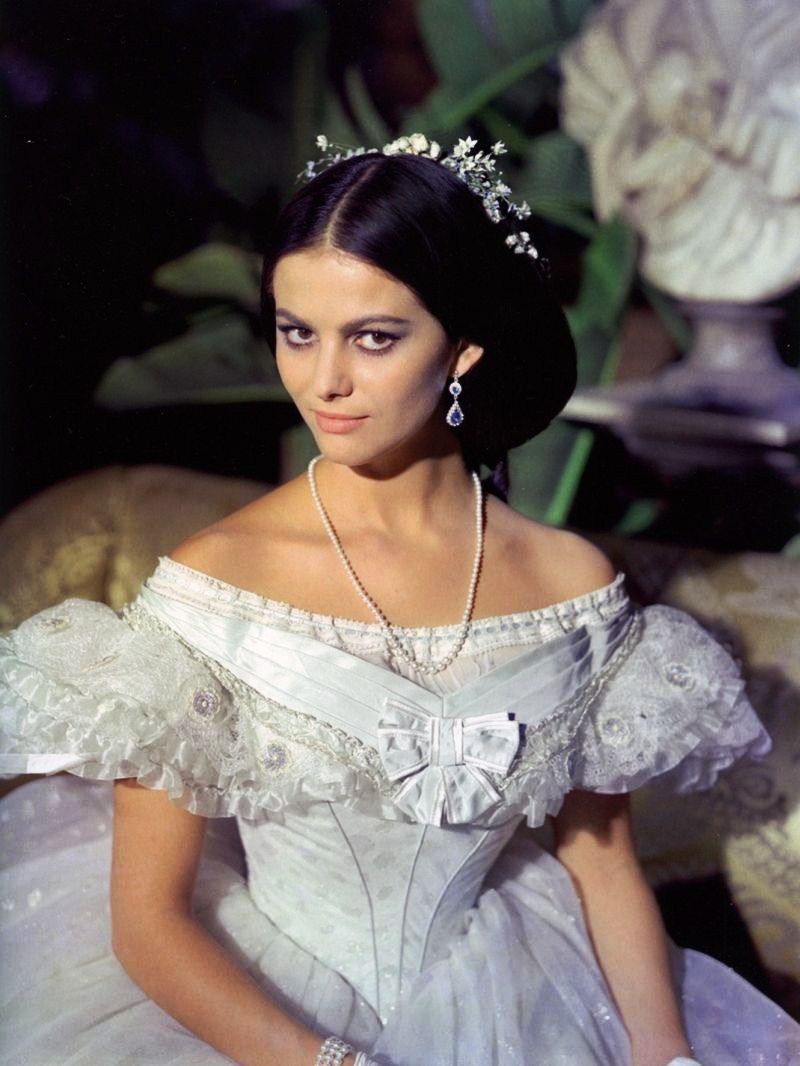
Finally, the show ended,
all the models
dutifully came back onto the runway, followed
by the designer, who received a
great round of applause and a thousand
“bravos!”—more than she had dared hope
for in prior years. She put her
hand to her lips, failed to hold back tears,
bowed slightly and blew a kiss the
audience.
Backstage
everyone was bobbing up and down with
elation, the models saying how much fun it had
been, the stylists collapsing
onto chairs, the seamstresses nodding that, si,
va bene, va bene, it went pretty well.
Champagne
was plucked
from a small refrigerator, foam
blasted
from the bottle, glasses were filled and Signora Palma stood up to speak,
thanking everyone for their hard
work, promising that they will all share in
the line’s success. Then, as glasses were
refilled, she
went over to Nicola, hugged her and said, “Bella,
you know you helped save my show.” Nicola
demurred, insisting it was obviously
the clothes that made the show.
“Si,”
said Signora
Palma, “the clothes were
beautiful, but there was something molte
speciale when you walk down the runway.
It was la magica! The
people
they fall in love with you.”
“I think they were falling
in love with Claudia
Cardinale.”
“C’e
vero, cara, but you reminded them of
everything they loved about Claudia,
when she was young and was an Italian girl who
make it very big as
international star. She even make Western
movies in America. But, you listen to me:
they saw
something about you,
Nicola Santini,
they loved very much. I
hear, I
see how they clap and shout. Mio Dio,
I never see this happen to a
model. Nicola, you can be a
very big star, as a model, I mean.
Maybe you become actress. You think about
this, eh?”
Nicola was herself
beginning to tear up and her
makeup began to run.
“Ah, mia
bambina,”
said Signora Palma, taking out a lace
handkerchief, “Look at my
Cardinale now!
Ah, aspett’!
This is the American
Cardinale—Santini! La
Santini!”
Nicola laughed a little and
expressed her
thanks for everything.
Signora
Palma said, “Is nothing. And, Nicola, I want
you back this fall for my next
show. I pay you to come, no worry about
money.”
Nicola smiled broadly and
said, “Grazie,
Signora, maybe I will.”
“And now, Nicola, I want to
invite you to my
home tonight for a little dinner, just close
friends. Bring your friend—?”
“Catherine.”
“Si,
Caterina. Bring her too.”
“Are you sure, Signora? Catherine doesn't speak
much Italian.”
“With my friends that’s not
problem. They all
speak English, better than me. I
no take no for an answer.”
Nicola assented, already
beginning to worry
about what to wear, asking, “Will
it
be dressy?”
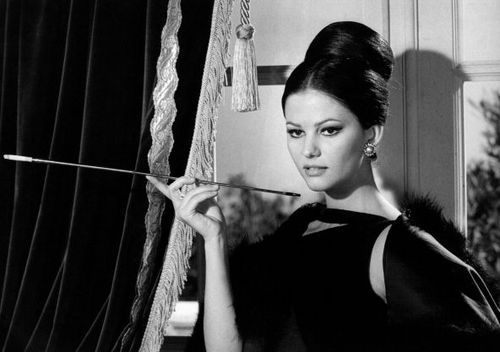 “No, you wear whatever you
want. When you
beautiful as you, Nicola, you wear
whatever you want. Everybody will
love you. Trust me. Capisce?”
“No, you wear whatever you
want. When you
beautiful as you, Nicola, you wear
whatever you want. Everybody will
love you. Trust me. Capisce?”
Signora
Palma turned to her assistant and told him to
call a driver to pick up Nicola
and her friend that evening, then to Nicola
said, “Okay, now I start to do
business. See if I make any money this year!”
And she was off to meet the
buyers.
The stylist asked Nicola if
she wanted her
make-up removed. Nicola glanced in
a mirror and said, “Maybe just the face, leave
the eyes alone.”
Almost miraculously, just
as Nicola left the
building, the clouds broke and revealed a
struggling disc of sun. She noticed
that some of those from the audience still
milling about were turning in her
direction and whispering to each other, “That
one was Cardinale!”
The odd thing about such
recognitions was not
that Claudia Cardinale was dead or even
retired; neither were any of the other
actresses: Cardinale was then only 48, Loren
51; Lollobrigida 58; Sandrelli 38,
and Lisi 49.
Part of the awe was
just the fun of seeing the models
impersonating the actresses, but much more of
it was tied to a nostalgic reverie of a Golden
Age of Italian cinema when such
actresses were considered goddesses on an
international scale. Patrizia Palma was well
aware of that
connection and had worked very hard to bring
some of that faded glamour back to
Italy in her collection.
Nicola was well aware that
she was not
Cardinale and that she didn’t want
to be regarded as anyone’s fantasy figure,
even if she regarded all fashion as
fantasy in some way. And she also
knew that, with Fashion Week ending the next
day, she could return to her
studies and go back to being Nicola Santini,
the girl from Belmont who somehow
had just had a very glamorous adventure.
The BMW was waiting for
her, and as they began
the drive back to her dorm, Nicola noticed it
was half past twelve and that she
was starving.
“Driver,” she said, “Do
you know the pizzeria Paper Moon on Via
Montenapoleone?”
“Si, Signorina.”
“Could we stop there? I
want to pick up a pizza
for my friends.”
“Certo,”
said
the driver, making a turn in Paper Moon’s
direction.
And
at that moment Nicola knew that there was
nothing in the world she wanted right then as
much as a good pizza.
© John Mariani, 2020
❖❖❖
NOTES FROM THE WINE CELLAR
THE
WINES OF ROCHIOLI
By
John Mariani
Photos by Kim Carroll
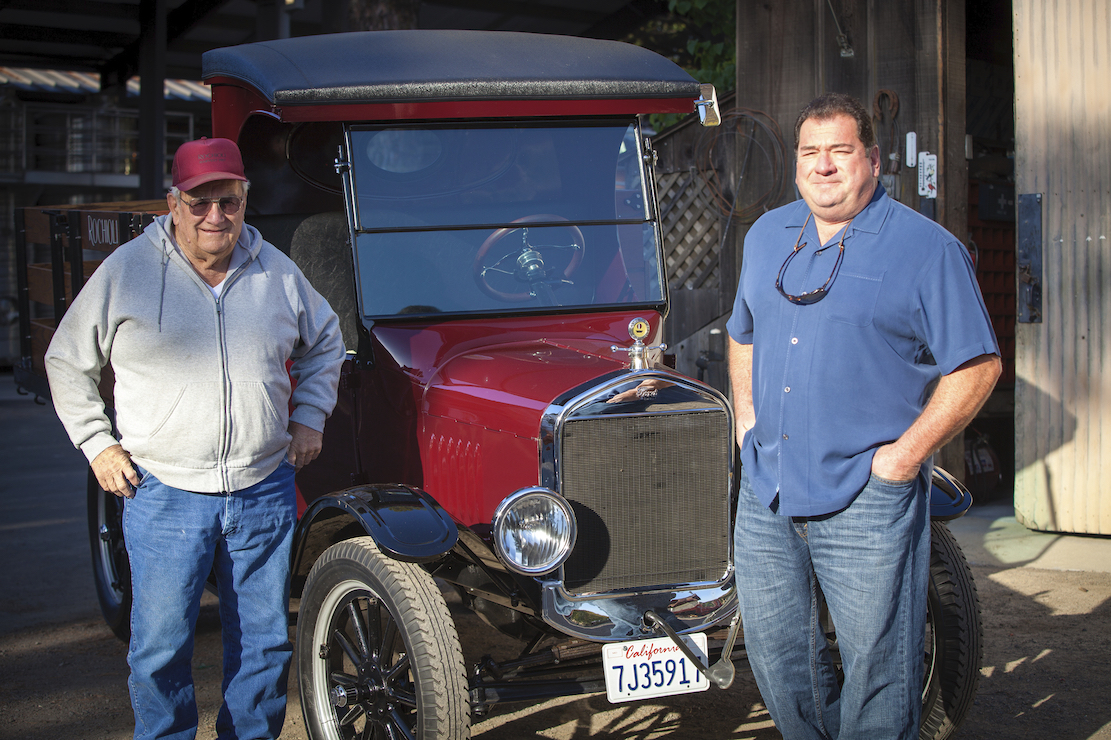
Joe, Jr and
Tom Rochioli
Whatever
one thinks of the wine media’s
numerical ratings, with 100 points being the
highest, few wineries in
California have so consistently had its wines
stay in the 90-and-above ranking
across the media as have those of Rochioli in
the Russian River Valley.
In fact, Rochioli was one of the
pioneers in
that valley. In 1978, when wine historian Leon
D. Adams wrote his authoritative
book Wines
of America, he merely said
that Russian River showed “potential as a
premium wine district,” but as far
back as 1959 Joe Rochioli, Sr., who’d emigrated
to the valley in 1911 from
Italy, and his son, Joe Rochioli, Jr., had
planted Cabernet Sauvignon and
Sauvignon Blanc in the region. In 1968 they
planted Pinot Noir and Chardonnay,
first selling the grapes to Davis Bynum, and
then bottling under their own
Fenton Acres label. The younger Joe’s son, Tom,
as winemaker, decided to put
the family name on their product in 1983 and
sold their first estate-bottled
Rochioli Pinot Noir in 1985, which was
immediately hailed the best in America
by Wine
Spectator.
Tom and his wife’s trip to
Burgundy gave them
more ideas and inspiration as to how to produce
better quality wine in the
Burgundian style, while always keeping
production low. I had a chance to
interview Tom (via Zoom) about the current state
of affairs at Rochioli and
California.
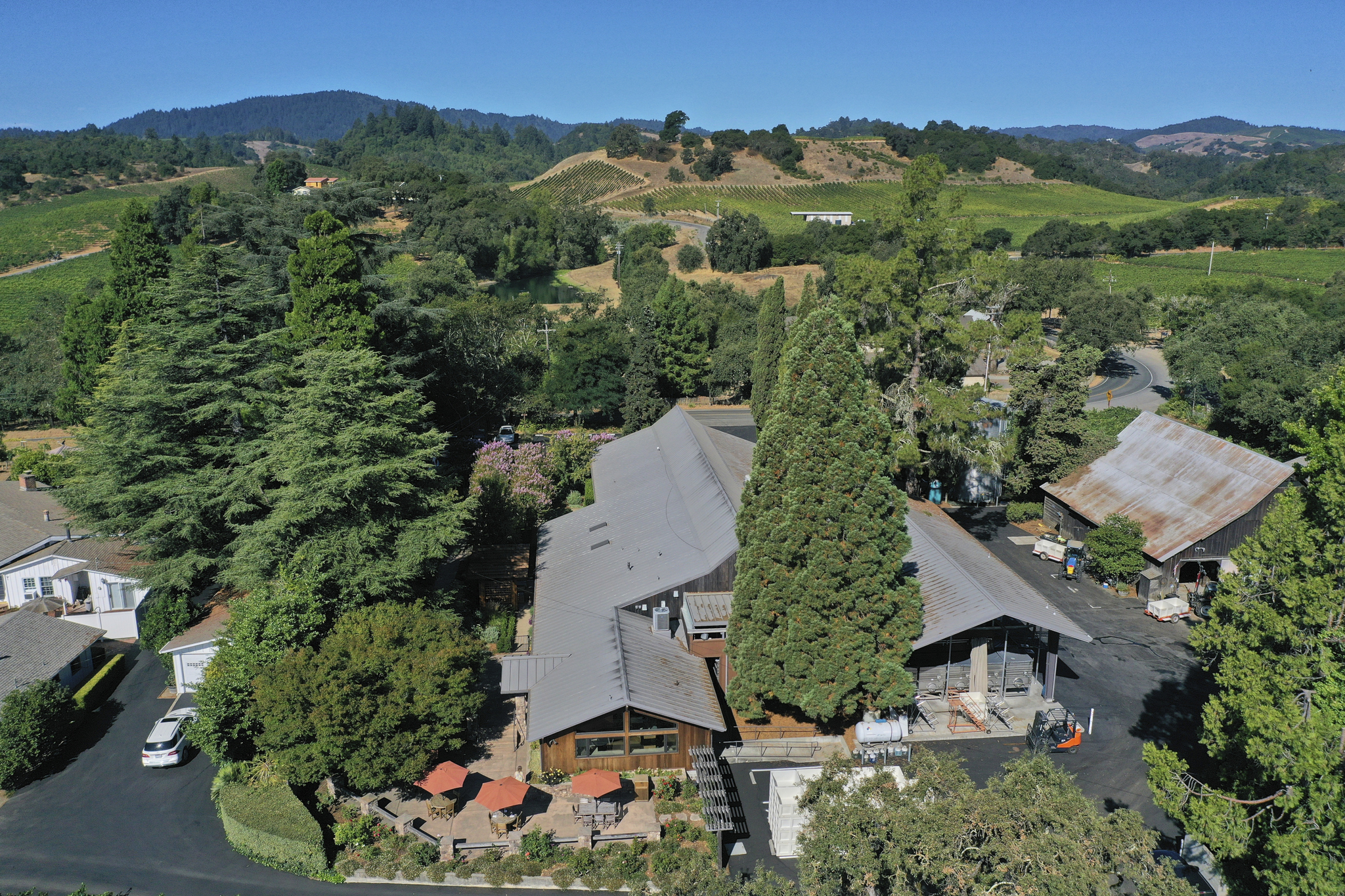 Q:
You say that
your wines would be “up there” if America had a
“quality rating”
of vineyards. Do you think this would be a good
idea and do you think it might
happen? Given the USA’s vast vineyards in so
many states would it be a national
rating or state by state?
Q:
You say that
your wines would be “up there” if America had a
“quality rating”
of vineyards. Do you think this would be a good
idea and do you think it might
happen? Given the USA’s vast vineyards in so
many states would it be a national
rating or state by state?
A: If a Grand Cru system existed in America, that’s where Rochioli would be. It would be a way to classify a great vineyard site/great wineries—if such a system existed.
Q: What do you think of the wine media’s numerical ratings?
A: We appreciate the pat on the back for being an ‘A’ student.
Q:
You make both
single-vineyard and estate wines, and you say
that the first are
hand-selected from the highest quality grapes in
that single lot. Then the
estate wines are blended from those same
vineyards. It is a little confusing
because it sounds like the single-vineyard wines
are from your very best grapes
but that the estate wines are even better.
Please expand.
A:
Rochioli is a very diverse
property—a lot of elevations, soil
types. In
1992 I identified the differences
in
the various sites and bottled them
separately. All Rochioli wines
are from estate-grown fruit. The
Pinot Noir clone is
proprietary. I select the barrels for
each site to create a  wine
that expresses that specific vineyard. The
remaining barrels that don’t
go into the SVs are what make up the Estate Pinot
Noir and Chardonnay.
It’s not lesser quality. It is a precise blend. We
take great pride in these
wines. The back label identifies which
vineyards are used.
Estate wines are blended with these vineyard
sites to reflect “classic
Rochioli” and “classic Russian River.”
wine
that expresses that specific vineyard. The
remaining barrels that don’t
go into the SVs are what make up the Estate Pinot
Noir and Chardonnay.
It’s not lesser quality. It is a precise blend. We
take great pride in these
wines. The back label identifies which
vineyards are used.
Estate wines are blended with these vineyard
sites to reflect “classic
Rochioli” and “classic Russian River.”
Q: Your family came from Lucca. Have you been back there? Do your wines in any way resemble those made in Italy?
A: A village outside of Lucca; I’ve been there three times. My grandfather was born there and emigrated here. They were farm workers. But our wines bear no resemblance to Tuscan wines. Originally the wines there were blends, which is not our style. We are more inspired by Burgundy.
Q: What was the “Italian work ethic”?
A: When I was seven years old, I’d sweep the yard, picked prunes. Work was a matter of pride and it was considered honorable. I’m working to bring my kids up the same way.
Q:
You say that
Cabernet Sauvignon did not do well back in 1959.
Why do you think
this was true?
A: It's way too cold. Not the right climate. There’s a lot of vigor on the Cab vines. I really believe that Pinot Noir has a home here in Russian River.
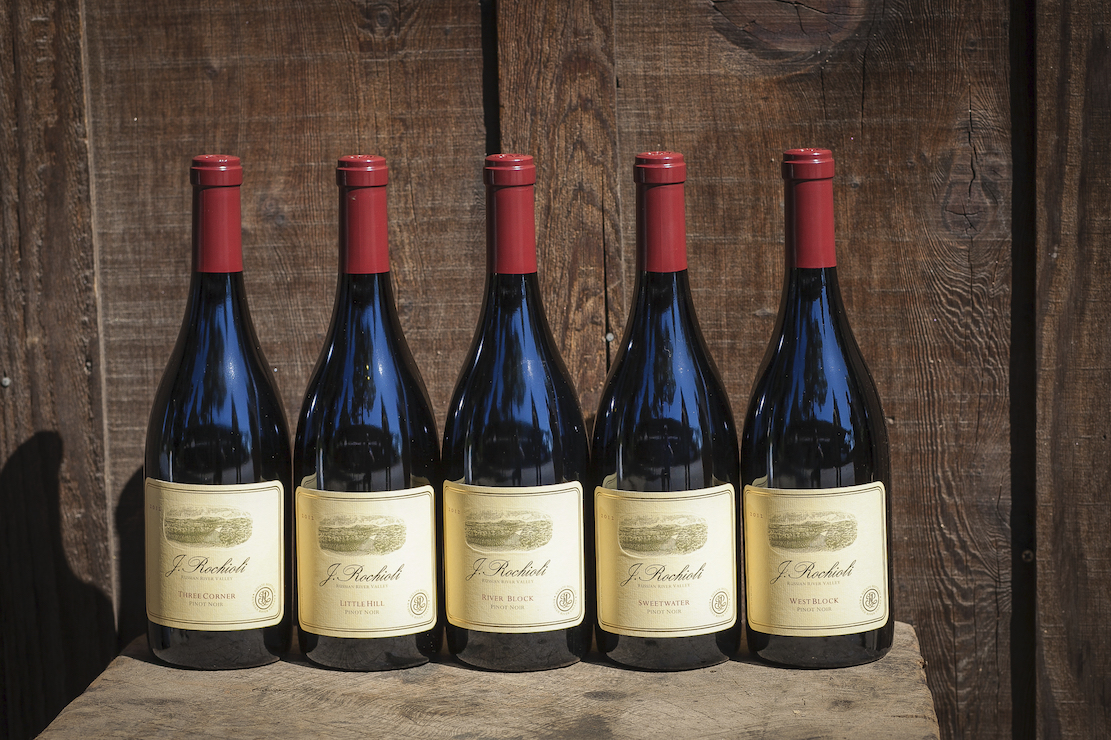 Q:
Re Pinot Noir,
is there a style you are aiming for? Russian
River produces a
lot of high alcohol Pinot Noirs. What are your
feelings about that idea vs the
Burgundian style.
Q:
Re Pinot Noir,
is there a style you are aiming for? Russian
River produces a
lot of high alcohol Pinot Noirs. What are your
feelings about that idea vs the
Burgundian style.
A:
The Rochioli style is
to be not overripe, nor green. I am not a fan
of plummy wines. It’s
about picking at the right time to find the right
balance. I work to get
it in the middle—richness and balance are
key. You have to enjoy these
wines. It’s about balance, good
acidity. Different sites show different
qualities. Winemaking is a moving target because
we depend on Mother Nature.
Now, with climate change, it’s not as cool as it
used to be, so our harvests
are earlier, but acid and pH haven’t changed much.
The newer rootstocks planted
may have had an effect on this, but minimal. If
and when we see pH and acids
changing dramatically, that’s when we would have
to consider making changes.
What we have seen is more Pierce’s disease
bacteria and Red Blotch virus, which
has no known vector but there is some speculation
that these changes could be
a result of the vectors preferring the warmer
conditions.
Q:
How would you
compare your region’s Pinot Noirs to those of
the Willamette
Valley?
A: There’s no comparison really. We are different.·
Q:
While Rochioli
is known for producing their own wines, you also
sell grapes to
some of Sonoma’s best-known producers. Can you
talk about those relationships
and what goes into that side of the business?
A:
These are long-term relationships we have; for
instance, with William Seylem,
since the late ‘70s. Several have the
Rochioli name on the bottle. We
don’t look at it as theirs versus ours; we farm
one way. With Allen
Vineyard’s latest replant William
suggested the clone. We are a part of
a team. It’s getting the best for
everyone. It’s a very
important side of the business. It’s not about
quantity. I grow the grapes as
if the wines would be made by me. These vineyards
are made for
winemakers. Communication is key.
We treat their
sections as if they own them.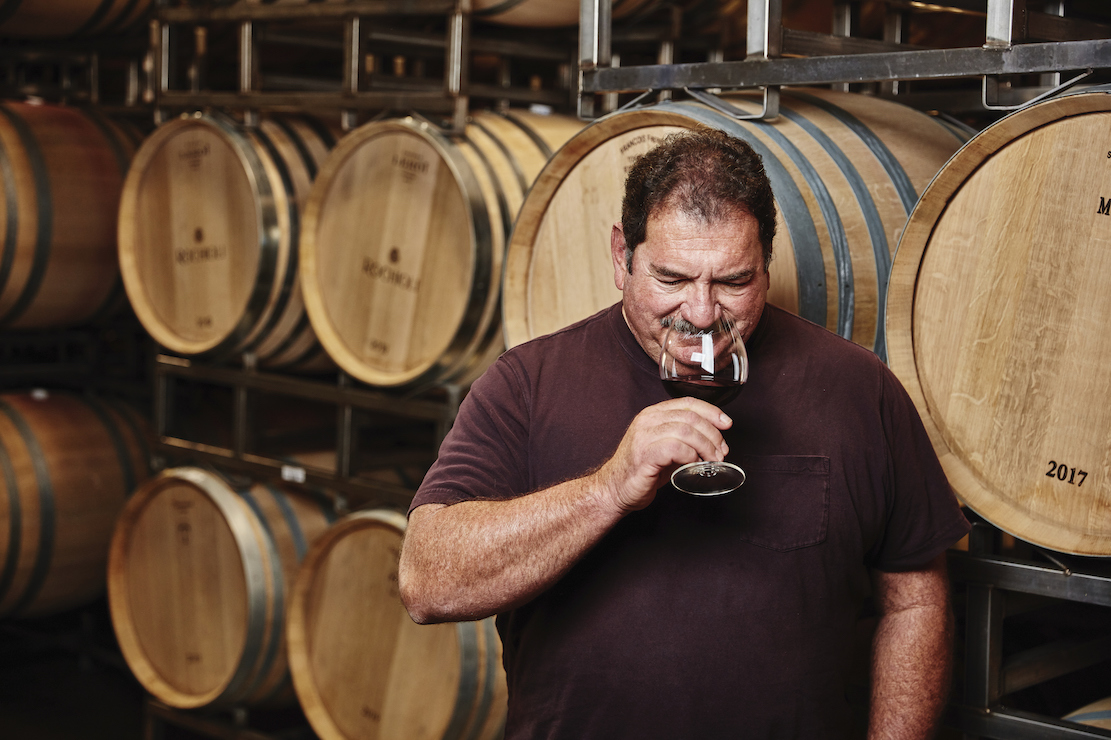
Q: While Rochioli is famous for Pinot Noir, you have said that making Chardonnay is the hardest of your wines to produce. Why is that?
A: With Pinot Noir the process is much easier. Chard is more labor intensive. I don’t want to over-press. We go straight to barrel, inoculate each barrel. The result is worth it. Careful thought on when to go through malolactic fermentation. Chardonnay takes the most effort, pressing the whole cluster, proper yields (low), get it into barrel immediately, individually inoculated. It’s a labor intensive process. The hardest is to make them distinct. It’s very much like making Grand Cru Burgundy, but in Russian River. It’s classic, balanced, interesting, not “white bread.” They are made to last. They age as well as any top California chard.
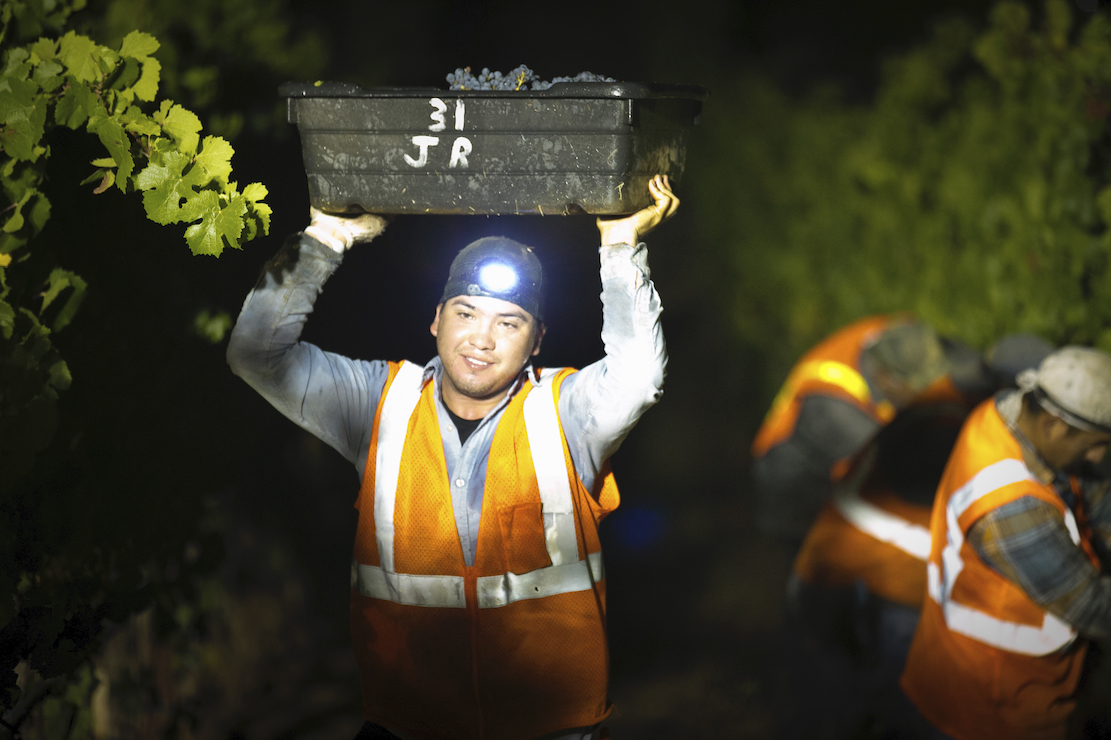
Q:
Do you have any
requests to make wines that can sell for, say,
$15?
Q: $15 wine? No, I stick to 12,000 cases; it’s all Estate. I like the lane I am in.
Q:
Are you worried about workers this fall for
harvest?
A: We have a crew that is anywhere from 3 years to 20-30 years. The wineries nearby share labor. Right now, I have the people.
Sponsored by

Any of John Mariani's books below may be ordered from amazon.com.
 The Hound in Heaven
(21st Century Lion Books) is a novella, and
for anyone who loves dogs, Christmas, romance,
inspiration, even the supernatural, I hope you'll find
this to be a treasured favorite. The story
concerns how, after a New England teacher, his wife and
their two daughters adopt a stray puppy found in their
barn in northern Maine, their lives seem full of promise.
But when tragedy strikes, their wonderful dog Lazarus and
the spirit of Christmas are the only things that may bring
his master back from the edge of despair.
The Hound in Heaven
(21st Century Lion Books) is a novella, and
for anyone who loves dogs, Christmas, romance,
inspiration, even the supernatural, I hope you'll find
this to be a treasured favorite. The story
concerns how, after a New England teacher, his wife and
their two daughters adopt a stray puppy found in their
barn in northern Maine, their lives seem full of promise.
But when tragedy strikes, their wonderful dog Lazarus and
the spirit of Christmas are the only things that may bring
his master back from the edge of despair. WATCH THE VIDEO!
“What a huge surprise turn this story took! I was completely stunned! I truly enjoyed this book and its message.” – Actress Ali MacGraw
“He had me at Page One. The amount of heart, human insight, soul searching, and deft literary strength that John Mariani pours into this airtight novella is vertigo-inducing. Perhaps ‘wow’ would be the best comment.” – James Dalessandro, author of Bohemian Heart and 1906.
“John Mariani’s Hound in Heaven starts with a well-painted portrayal of an American family, along with the requisite dog. A surprise event flips the action of the novel and captures us for a voyage leading to a hopeful and heart-warming message. A page turning, one sitting read, it’s the perfect antidote for the winter and promotion of holiday celebration.” – Ann Pearlman, author of The Christmas Cookie Club and A Gift for my Sister.
“John Mariani’s concise, achingly beautiful novella pulls a literary rabbit out of a hat – a mash-up of the cosmic and the intimate, the tragic and the heart-warming – a Christmas tale for all ages, and all faiths. Read it to your children, read it to yourself… but read it. Early and often. Highly recommended.” – Jay Bonansinga, New York Times bestselling author of Pinkerton’s War, The Sinking of The Eastland, and The Walking Dead: The Road To Woodbury.
“Amazing things happen when you open your heart to an animal. The Hound in Heaven delivers a powerful story of healing that is forged in the spiritual relationship between a man and his best friend. The book brings a message of hope that can enrich our images of family, love, and loss.” – Dr. Barbara Royal, author of The Royal Treatment.
 |
The Encyclopedia of American Food and Drink by John F. Mariani (Bloomsbury USA, $35) Modesty forbids me to praise my own new book, but let me proudly say that it is an extensive revision of the 4th edition that appeared more than a decade ago, before locavores, molecular cuisine, modernist cuisine, the Food Network and so much more, now included. Word origins have been completely updated, as have per capita consumption and production stats. Most important, for the first time since publication in the 1980s, the book includes more than 100 biographies of Americans who have changed the way we cook, eat and drink -- from Fannie Farmer and Julia Child to Robert Mondavi and Thomas Keller. "This book is amazing! It has entries for everything from `abalone' to `zwieback,' plus more than 500 recipes for classic American dishes and drinks."--Devra First, The Boston Globe. "Much needed in any kitchen library."--Bon Appetit. |
"Eating Italian will never be the same after reading John Mariani's entertaining and savory gastronomical history of the cuisine of Italy and how it won over appetites worldwide. . . . This book is such a tasteful narrative that it will literally make you hungry for Italian food and arouse your appetite for gastronomical history."--Don Oldenburg, USA Today. "Italian
restaurants--some good, some glitzy--far
outnumber their French rivals. Many of
these establishments are zestfully described
in How Italian Food Conquered the World, an
entertaining and fact-filled chronicle by
food-and-wine correspondent John F.
Mariani."--Aram Bakshian Jr., Wall Street
Journal.
"Equal parts
history, sociology, gastronomy, and just
plain fun, How Italian Food Conquered the
World tells the captivating and delicious
story of the (let's face it) everybody's
favorite cuisine with clarity, verve and
more than one surprise."--Colman Andrews,
editorial director of The Daily
Meal.com. "A fantastic and fascinating
read, covering everything from the influence
of Venice's spice trade to the impact of
Italian immigrants in America and the
evolution of alta cucina. This book will
serve as a terrific resource to anyone
interested in the real story of Italian
food."--Mary Ann Esposito, host of PBS-TV's
Ciao
Italia. "John Mariani has written the
definitive history of how Italians won their
way into our hearts, minds, and
stomachs. It's a story of pleasure over
pomp and taste over technique."--Danny Meyer,
owner of NYC restaurants Union Square
Cafe, The Modern, and Maialino.
|
 |
 |
 |
 |
 |
 |
 |
 |
 Everett Potter's Travel Report:
Everett Potter's Travel Report: 
 Eating Las Vegas
JOHN CURTAS has been covering the Las Vegas
food and restaurant scene since 1995. He is
the co-author of EATING LAS VEGAS – The 50
Essential Restaurants (as well as
the author of the Eating Las Vegas web site: www.eatinglasvegas.
He can also be seen every Friday morning as
the “resident foodie” for Wake Up With the
Wagners on KSNV TV (NBC) Channel 3 in
Las Vegas.
Eating Las Vegas
JOHN CURTAS has been covering the Las Vegas
food and restaurant scene since 1995. He is
the co-author of EATING LAS VEGAS – The 50
Essential Restaurants (as well as
the author of the Eating Las Vegas web site: www.eatinglasvegas.
He can also be seen every Friday morning as
the “resident foodie” for Wake Up With the
Wagners on KSNV TV (NBC) Channel 3 in
Las Vegas.
MARIANI'S VIRTUAL GOURMET
NEWSLETTER is published weekly. Publisher: John Mariani. Editor: Walter Bagley. Contributing Writers: Christopher Mariani,
Robert Mariani, Misha Mariani, John A. Curtas, Gerry Dawes, Geoff Kalish,
and Brian Freedman. Contributing
Photographer: Galina Dargery. Technical
Advisor: Gerry
McLoughlin.
If you wish to subscribe to this
newsletter, please click here: http://www.johnmariani.com/subscribe/index.html
© copyright John Mariani 2020

